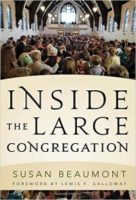
The pandemic unraveled staff team structures. Resignations and retirements were at an all-time high. Downsizing was necessary for some congregations. Others hired new staff to respond to the unique needs of a pandemic era. Now things are settling down and leaders are questioning whether they have the right configuration of staff. Fruitful staffing conversations begin with the congregation’s unique circumstances and are guided by a realistic vision of its future.
Many congregations have experienced significant numerical decline over the past three years—in both attendance and operating budgets—and now are coming to terms with the need to downsize structures. Difficult decisions must be made.
Other congregations are delightfully growing and are exploring opportunities for adding staff. They aren’t sure how to prioritize competing demands for more staff.
There are no easy answers to “How should I design my team?” No outside expert holds the key. However, these five guidelines can help you frame better conversations with your leaders about the structure of your team:
1. Be intentional about your payroll investment strategy.
Payroll expense is the largest single line item in most operating budgets. Studies show that the typical mainline Protestant church spends between 45–55% of its operating budget on payroll expenses (salary, benefits, and continuing education). No congregation should strive to be “average’ in the amount they spend on payroll. However, if you are allocating significantly more or less than the norm, you should know why.
Faced with staffing choices, most congregations start with what they did the previous year. Design decisions are overly influenced by the increase or decrease in the current year’s giving. We should be asking better strategic questions about our payroll investment:
- What staffing changes are required to support our current strategic priorities?
- What amount of money can we invest in staff and still maintain our physical plant and pursue our vision for ministry?
- Are we being just and fair in how we pay our employees?
- Does our investment in payroll support or diminish the ministry of our laity?
- Are you investing in staff to support anticipated growth?
- Are you pursuing a new initiative that requires upfront investment in specialized staff? If so, what is your plan for funding staff on a long-term basis to return to a more sustainable staffing model?
- If you are downsizing, have you planned for downsizing program and service expectations accordingly?
Questions like these help shift leaders’ attention from how to tweak the past to how to fund the future.
2. Prioritize new growth initiatives over past accomplishments.
Your staff design most likely reflects your historical strengths as a congregation–children, youth, and music. These are not necessarily your priorities moving forward. What is God calling your congregation to do or become next? Does your staffing structure support your shift in priorities?
We must eliminate the idea that a job in the church is a job for life. Perhaps you don’t need a children’s director any longer because there are too few children in the congregation. Perhaps new priorities call for a missions coordinator instead. This is a season for making bold and hard staffing decisions. You cannot limp along as a congregation waiting for the retirement of staff members who no longer meet your needs. Staff for your future, not your past.
3. Rebalance administration and programming.
Historically, mid-sized and large churches have prioritized specialized program staff over administrative support. As money became available, congregations would add specialists in children, youth, mission, pastoral care, small groups, etc. These specialists would create programming options for attracting new members.
The administrative side of the staff remained less developed. Only when the program team was fully developed would congregations hire administrative specialists, replacing a church secretary or office manager with specialists in finance, facilities management, communication, information technology and human resources.
This sequence for developing the staff team—program first, admin later—is reversing itself. Church futurists predict that traditional programming will not be the driving force for growth. Instead, advances in digital ministry and resources for building faith intergenerationally and in family units will be in greater demand. Many churches will de-specialize their program teams—with smaller numbers of clergy and program staff serving broader constituent groups.
Specialization on the administrative side of the team will increase. Churches will hire more sophisticated help with communication, digital ministry, audio-visual support, and information systems.
4. Don’t underpay your high performing staff to finance more hires.
Church staff have been asked to do more with less over the past decade. We’ve postponed raises. We’ve paid bonuses rather than increasing base pay. All of this is happening in an inflationary environment where stagnant salaries are buying less and less.
The future of your congregation depends on the adaptive skills of your staff. You need to keep your best people. Don’t err on the side of paying your staff less so that you can hire more bodies. It’s better to have fewer high performing staff members. Do the hard work of letting go of under-performers to free up money for better salaries and new hires.
5. Don’t respond to a lack of volunteerism by hiring more staff.
I have worked with many churches over the years, and not one of those churches felt they had all the staff they needed. There will always be more ministry ideas than you can support. Adding more staff increases the generation of more ideas—including ideas for programs and services people don’t have time or energy to attend. More isn’t always better. Overstaffed churches diminish the role of laity and develop a culture that is overly dependent on staff to do the ministry of the church.
If volunteerism is waning in your congregation, focus on why, and do a better job of volunteer management. Don’t add staff to do the work of the laity. If a program or area isn’t supported by volunteers, maybe you don’t need the program.
We will be involved in conversations about staff team design for some time. No perfect design will solve all your problems. You must work with the options in front of you. Think about the design that you want to live into five years from now and then make choices today that will move you in the general direction of your ideal.
Susan Beaumont is a coach, educator, and consultant who has worked with hundreds of faith communities across the United States and Canada. Susan is known for working at the intersection of organizational health and spiritual vitality. She specializes in large church dynamics, staff team health, board development, and leadership during seasons of transition.
With both an M.B.A. and an M.Div., Susan blends business acumen with spiritual practice. She moves naturally between decision-making and discernment, connecting the soul of the leader with the soul of the institution. You can read more about her ministry at susanbeaumont.com.



